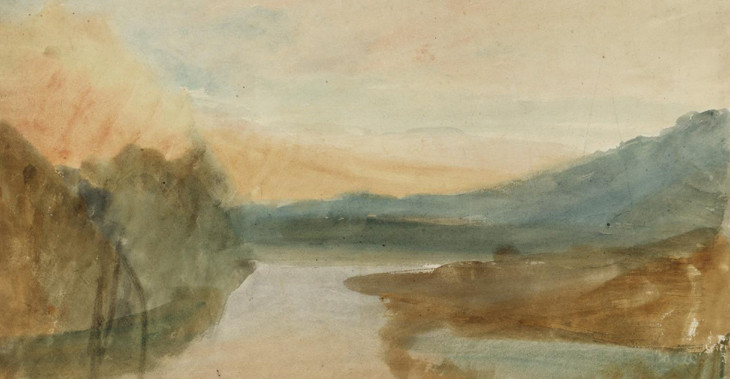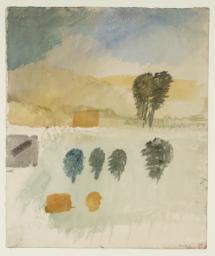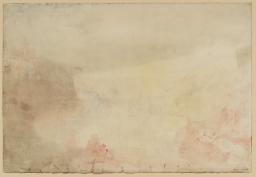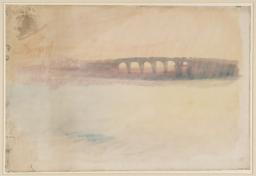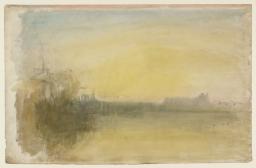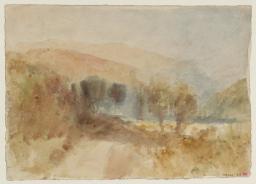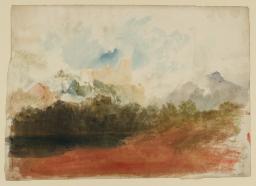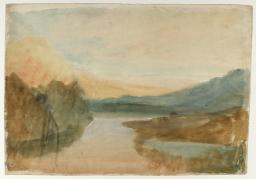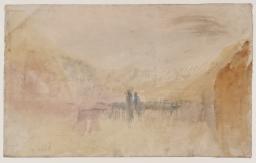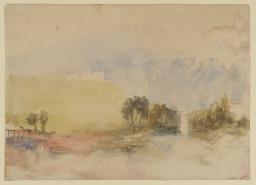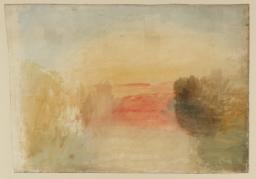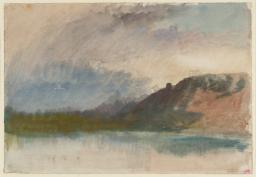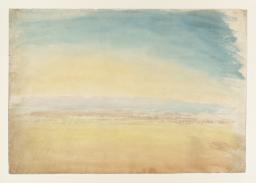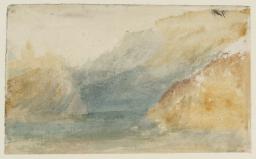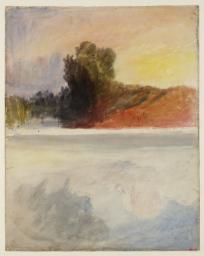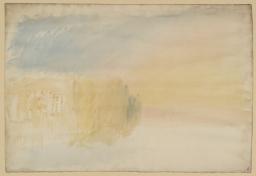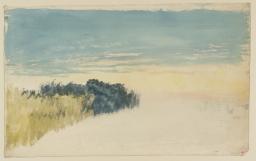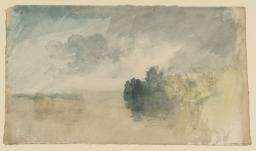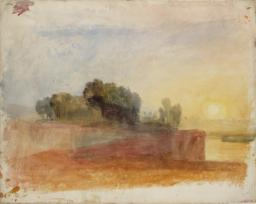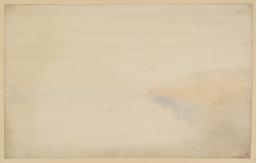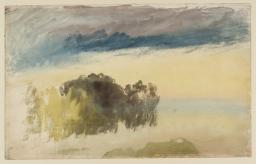From the entry
The loose, atmospheric landscape watercolours catalogued in this small section are, to use the formulation of A.J. Finberg, the Turner Bequest’s first cataloguer, ‘colour beginnings’, and have been selected from Turner Bequest section CCLXIII, the most prominent of such groupings in Finberg’s 1909 Inventory. They evoke settings of low hills, woods, lakes and rivers with occasional structures such as bridges and towers, seen against a range of skies, glowing empty at dawn or sunset or populated by dramatic clouds. (Similar works where the effects of sun and weather outweigh the landscape elements are dealt with in a separate section of this catalogue.) Whether recalled or invented, the quiet, unspectacular settings are perhaps generally evocative of the British landscape rather than the more dramatic scenery encountered on some of Turner’s Continental tours. No further comment on the potential subject matter is made here, but there is further discussion and comparison within ...
D25182, D25188, D25191, D25223, D25230, D25233, D25235, D25248, D25249, D25267, D25285, D25300, D25303, D25321, D25335, D25351, D25359, D25363, D25377, D25402, D25420, D25493, D25495, D25498, D25499
Turner Bequest CCLXIII 60, 66, 69, 101, 108, 111, 113, 126, 127, 145, 163, 178, 181, 199, 213, 229, 237, 241, 254, 279, 297, 370, 372, 375a, 375b
Turner Bequest CCLXIII 60, 66, 69, 101, 108, 111, 113, 126, 127, 145, 163, 178, 181, 199, 213, 229, 237, 241, 254, 279, 297, 370, 372, 375a, 375b
The loose, atmospheric landscape watercolours catalogued in this small section are, to use the formulation of A.J. Finberg, the Turner Bequest’s first cataloguer, ‘colour beginnings’,1 and have been selected from Turner Bequest section CCLXIII, the most prominent of such groupings in Finberg’s 1909 Inventory.2 They evoke settings of low hills, woods, lakes and rivers with occasional structures such as bridges and towers, seen against a range of skies, glowing empty at dawn or sunset or populated by dramatic clouds. (Similar works where the effects of sun and weather outweigh the landscape elements are dealt with in a separate section of this catalogue.)
Whether recalled or invented, the quiet, unspectacular settings are perhaps generally evocative of the British landscape rather than the more dramatic scenery encountered on some of Turner’s Continental tours. No further comment on the potential subject matter is made here, but there is further discussion and comparison within individual entries. The most unusual work is half conventional landscape, half isolated trees and patches of colour, and appears to be in the nature of a test sheet (Tate D25420; Turner Bequest CCLXIII 297).
Many similar works were made in the development of Turner’s major series of watercolours for engraving projects such as the Picturesque View in England and Wales (published 1827–38); see the ‘England and Wales Colour Studies c.1825–39’ section of this catalogue. Some of those works are closely comparable in appearance and technique, but their general compositions or sometimes quite slight details or correspondences in form or colour have led to their being linked with specific finished designs. Finberg dated the whole ‘Colour Beginnings’ section to around 1820–30, but those here are here given a broader range of 1820–40, except in cases where a watermark provides a terminus post quem, or occasional other factors come into play. This reflects the artist’s production of similar ‘colour beginnings’ in relation to dated projects during the 1820s and 1830s.
The selection has been informed by Eric Shanes’s close examination of the Turner Bequest CCLXIII sheets in his 1997 Watercolour Explorations catalogue, compiled for a Tate exhibition during his Magnox Electric Turner Scholarship.3 He categorised Turner Bequest CCLXII sheets and along with similar works in Finberg’s Turner Bequest sections CCCLXIV (‘Miscellaneous: Colour’4) and CCCLXV (also ‘Miscellaneous: Colour’5), in relation to England and Wales and to many other print projects and broader themes. His comments are noted in individual entries here.
Technical notes:
The works in this section are generally characterised by broad watercolour washes on white wove paper. Eric Shanes has discussed the techniques of the ‘colour beginnings’ in some detail.6 In particular he notes that Turner worked on groups of designs at the same time, sometimes within the same sheet of paper and subsequently divided.7 Indeed, two of the works here (D25498, D25499; CCLXIII 375a, 375b) remain physically joined albeit unrelated compositions, one above the other.
See Eric Shanes, ‘Beginnings’ in Evelyn Joll, Martin Butlin and Luke Herrmann (eds.), The Oxford Companion to J.M.W. Turner, Oxford 2001, pp.21–3; among many other accounts, see also Andrew Wilton in Martin Butlin, Wilton and John Gage, Turner 1775–1851, exhibition catalogue, Royal Academy, London 1974, p.26; and Andrew Wilton, J.M.W. Turner: His Life and Work, Fribourg 1979, p.187.
A.J. Finberg, A Complete Inventory of the Drawings of the Turner Bequest, London 1909, II, pp.814–45, CCLXIII 1–390, as ‘Colour Beginnings’, c.1820–30.
See Eric Shanes, Turner’s Watercolour Explorations 1810–1842, exhibition catalogue, Tate Gallery, London 1997, pp.93–107; the author is also very grateful to fellow Tate Turner cataloguers Alice Rylance-Watson and John Chu for intensive discussions in late October 2014, when the contents of the sections of separate sheets then remaining to be catalogued were largely drawn up.
How to cite
Matthew Imms, ‘Lowland and River Colour Studies c.1820–40’, December 2015, in David Blayney Brown (ed.), J.M.W. Turner: Sketchbooks, Drawings and Watercolours, Tate Research Publication, November 2016, https://www

